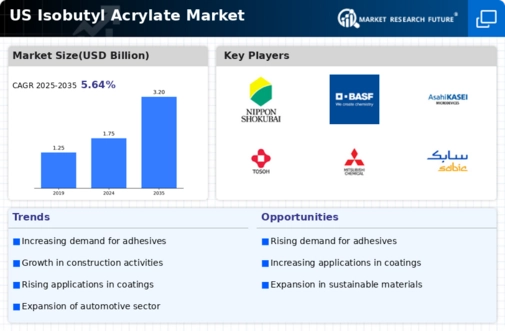Growth in the Textile Industry
The growth in the textile industry is emerging as a significant driver for the isobutyl acrylate market. As the demand for functional textiles increases, manufacturers are increasingly incorporating isobutyl acrylate into textile coatings and finishes to enhance properties such as water resistance and durability. In 2025, the textile segment is projected to account for approximately 15% of the total market share, with a growth rate of around 6% annually. This trend is fueled by the rising consumer preference for high-performance fabrics in apparel and home textiles. Consequently, The isobutyl acrylate market will benefit from ongoing innovations in textile applications., as manufacturers seek to meet the evolving demands of consumers.
Expansion of the Paints and Inks Sector
The isobutyl acrylate market benefits from the expansion of the paints and inks sector, which is experiencing robust growth in the United States. The increasing preference for water-based paints, driven by environmental regulations and consumer demand for low-VOC products, is likely to enhance the market for isobutyl acrylate. In 2025, the paints and inks segment is anticipated to represent around 30% of the overall market, with a projected growth rate of 4% annually. This growth is attributed to the rising construction activities and the need for high-quality, durable finishes in both residential and commercial applications. As manufacturers adapt to these trends, the demand for isobutyl acrylate as a key raw material in paint formulations is expected to rise, further propelling the market forward.
Rising Demand for Coatings and Adhesives
The isobutyl acrylate market experiences a notable surge in demand due to its extensive application in coatings and adhesives. The construction and automotive industries are particularly significant consumers, as they require high-performance materials that offer durability and resistance to environmental factors. In 2025, the coatings segment is projected to account for approximately 40% of the total market share, driven by the increasing need for protective coatings in various applications. Additionally, the adhesive segment is expected to grow at a CAGR of around 5% over the next few years, reflecting the ongoing trend towards lightweight materials and efficient bonding solutions. This rising demand for coatings and adhesives is a key driver for the isobutyl acrylate market, as manufacturers seek to innovate and meet the evolving needs of these industries.
Regulatory Support for Chemical Manufacturing
Regulatory support for chemical manufacturing is a pivotal factor influencing the isobutyl acrylate market. The U.S. government has implemented various policies aimed at promoting the growth of the chemical sector, including incentives for sustainable practices and investments in research and development. These initiatives are expected to bolster the production capabilities of isobutyl acrylate manufacturers, facilitating innovation and enhancing competitiveness. In 2025, it is anticipated that regulatory support could lead to a 5% increase in production capacity across the industry, thereby meeting the rising demand from end-use sectors. This supportive regulatory environment is likely to create a favorable landscape for the isobutyl acrylate market, encouraging investment and growth.
Technological Innovations in Production Processes
Technological innovations in production processes are playing a crucial role in shaping the isobutyl acrylate market. Advances in manufacturing techniques, such as the development of more efficient catalytic processes, are likely to enhance production yields and reduce costs. This is particularly relevant as the market faces increasing pressure to provide high-quality products at competitive prices. In 2025, it is estimated that improved production technologies could lead to a reduction in production costs by up to 10%, thereby making isobutyl acrylate more accessible to a wider range of applications. Furthermore, these innovations may also contribute to sustainability efforts by minimizing waste and energy consumption during production, aligning with the broader trends in the chemical industry.

















Leave a Comment